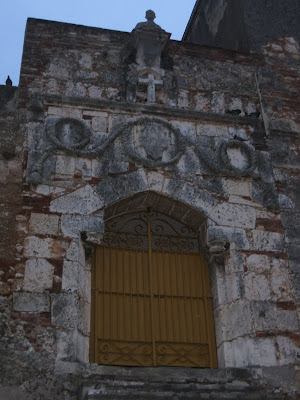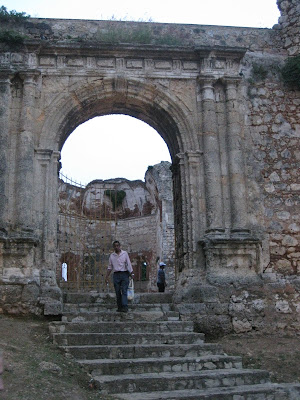I got back from the capital this weekend. Wednesday I woke up early, bought food, sat at the bus station, called two of my more spontaneous friends and told them to come with me. I was itching to see the real Santo Domingo, the first capital city of the Americas and witness a more raw, urban side to this country. Getting off the buss station we decided to walk to the Zona Colonial, after all it was a mere three inches on my city map. Several hours later we were deep in the heart of a Haitian market. When I think market I tend to think of what I saw in Spain and Chile; fruits, vegetables, cheeses, fish and meats all organic, lovingly displayed and ready for the conscientious consumer to glide by, basket in hand, picking and choosing between equally beautiful fruits of the earth. Then there is the artesanía, my personal favorite, where men and women draw from their cultural heritage of craftsmanship and fashion all manner of pleasantries, both useful and decorative from yarn, metal, leather, wood and clay. I smiled walking through the market in Santo Domingo, because although my surroundings had all the aesthetic comfort of a gas station restroom, there is something very “aha!” about being in a place where the rest of the world, the struggling world, lives and breathes and sells and buys and chats and walks and yells…. This is it. More humans, more brothers and sisters, know this reality than the reality that I wake up to everyday. It’s a hello real world moment, and not the real world spoken of on Monday mornings and in graduation ceremonies. Giant piles of cabbages, eggplants, carrots, pineapples and papayas spill over onto the broken sidewalk attracting swarms of flies. There are towers of recycled jugs filled with milk, juice and rum, some of which read “battery acid” and “anti-freeze” on the label. Tall men, the tallest I’ve seen in this country, carry giant trash bags full of goods all under the watchful eye of Chinese bosses; they dump them out on the street in front of an endless string of nail salons and lingerie stores. Haitian women then dig through the piles of rubber sandals, ked-like shoes, more underwear and mountains of brightly colored tops and bottoms, embellished with sequins and provocative statements in English, all made of stretchy curve-hugging fabric. Vendors cook over steaming wok-like dishes, screaming to overcome the noise of the freeway overhead. The smell of foreign spices blends with black exhaust smoke and urine. I’ll never forget it.
Street vendors reminded me of cholera which I should probably comment about. Thank you all for your concern and I’m sorry I haven’t responded to some of your messages. Since October the epidemic has killed over two thousand in Haiti and only thirty-two in the Dominican Republic. The riots provoked by the shutting down of the Haitian/Dominican border seems to be subsiding after some refereeing on the part of the UN, but the disease itself continues to spread and much of the donated medicine has fallen into corrupt hands and simply disappeared. As the Haitian president recently showed up intoxicated for his annual address, the UN is even more clueless as to how to bring relief to the Haitian people. Its election time in Haiti as well, please pray for this country, read about it, talk about it. As for me I’m absolutely safe. I don’t eat dairy or food off the street and we’re soaking all our veggies in chlorine water (every salad tastes like a swimming pool).
Anyway, we checked into a tiny, cheap 1940s hotel run by an ancient German-Dominican named Aida that had fantastic pictures of herself hung up on every wall. We visited old cigar shops full of everything from fine Cubans to questionable Jamaican spliffs, we scaled an ancient Spanish fort and scoured the sea as did Columbus and Drake the pirate, visited the first Cathedral in the Americas, found a hole in the wall that sold Mexican tacos with passion fruit juice, enjoyed the giant lit Christmas tree in Plaza España, watched people get married, ate more tacos, and ended the night beneath somber crumbling monastary walls with a cheap bottle of wine, attendees at a street party with dancing and Caribbean jazz. The next day Aida made us breakfast and we bumbled about watching the colonial zone wake up. The atmosphere was unlike anything I’ve seen in this country; I saw several gay couples, women strolling along unaccompanied with dogs on leashes, old Haitian and Dominican scholars drinking coffee and reading passages from old books then yelling at one another in both languages, Chinese families enjoying a morning in the park, jabbering away to one another in Spanish. That afternoon we hit up three museums all for free because it was the “free museums for everyone day!” What a wonderful idea, we sure felt lucky.
As for other travels since my last blog, we visited the peninsula of Samaná. I got to kayak through a mangrove…grove. It was incredible and exciting as tiny blue crabs the size of spiders would fall from the branches onto your head and into your boat and you had to remain perfectly poised or else the kayak would tip and you would be face down in stinky murky silt! We also hiked to Salto Limon, a giant waterfall in the forest near Parque de los Haitises. The community in Samaná was fascinating; half of the population descended from African American freed slaves that immigrated from Louisiana and Alabama after the Civil War. They were paid to come to the Dominican Republic because the Dominican government was trying to develop their agricultural sector to compete with Cuba at the time and these former slaves were reported to be expert farmers. For this reason they have English names like Joshua Smith, Wilson Moor, Glady’s Johnson etc. and the older generation still speaks English with a southern accent. The other half of the Samaná community has not done so well; I’ve seen quite a bit of rural poverty here, but this was the first time I passed through villages where full grown adults were actually lacking clothing and had to tie rags around their waists.
Finals are over, they were really challenging. Its been a great semester, I’ve learned so much. Goodness.
I had my last day at Acción Callejera and it was of course, very sad and very sweet. Three of my Haitian students showed up badly burned with their little heads, arms and chests all wrapped up in white bandages and plaster. Pipo made a joke in Spanish of which he was very proud, “Look Kati, I’m black and white now, like a cow!” My stomach turned, how could I leave them like this, its just so unfair. Their smiles gave me strength though, I tried to tell them it was my last day but they didn’t understand so I had one of the other boys translate. They gave me a piece of wood with a watermelon painted on it, its really beautiful. After hugs and high fives and all the fist pounds I taught them (rocket ship, jelly fish, turkey, snail..) I headed out feeling heart broken, overwhelmed and very very grateful. That wasn’t the last time I saw them though, yesterday morning I was walking by the Alta Gracias Catholic Church and a chorus of little man voices called my name out of nowhere, “Kati! Kati! Amiiiiiiiiga! Look over here, we’re in the cage!” Eight of them were sleeping behind a cement wall along side the church, framed in by a giant metal grate, next to an alter with lit candles and the Virgin Mary. That picture will never leave me. I went over and it was hugs all around all over again. Somehow this meeting gave me more peace as I walked away the second time. If Mary does indeed intercede for us as they believe so strongly, she’s never had a more worthy petition nor children more deserving of her maternal care.
I love you all so much, thank you for your support and love this semester. I’m speechless and grateful, God is good.




























